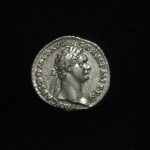Silver Denarius of Emperor Domitian, 81 CE - 96 CE
Silver
C.4601
Obverse: IMP CAES DOMIT AVG GERM PM TR P V; Bust of the Emperor Crowned with a Laurel Wreat Reverse: IMP XI COS XII CENS P PP; Minerva Standing to...
Obverse: IMP CAES DOMIT AVG GERM PM TR P V; Bust of the Emperor Crowned with a Laurel Wreat
Reverse: IMP XI COS XII CENS P PP; Minerva Standing to the Left, Holding a Spea
Domitian was the younger son of the emperor Vespasian. Although his older brother Titus occupied the throne from A.D. 79 to 81, while Domitian was growing up, he was not given any real political power. Because of this, Domitian always felt a certain amount of resentment towards his elder brother, spurring the rumors that Domitian poisoned Titus, although these are generally believed to be false. Like Tiberius and Caligula before him, Domitian sought to be absolute ruler. He scandalized the Senate and the rest of the Roman aristocracy by having statues of himself erected and by insisting that people refer to him as "Lord and God.” The Senate grew to loathe and fear Domitian, hatching numerous plots against his life, and he, in turn, became increasingly suspicious towards them. In the last three or four years of Domitian’s reign, the senators lived in fear of their lives, reaping the fruit of their conspiracies. In the end, it would be this backstabbing and mistrust on both sides that would doom Domitian. In 95, he eliminated his two praetorian prefects. The two men who replaced them, Petronius Secundus and Norbanus, fearing that they too would soon be eliminated, decided to form a successful conspiracy to assassinate Domitian.
How many hands have touched a coin in your pocket or purse? What eras and lands have the coin traversed on its journey into our possession? As we reach into our pockets to pull out some change, we rarely hesitate to think of who might have touched the coin before us, or where the coin will venture to after it leaves our hands. More than money, coins are a symbol of the state that struck them, of a specific time and location, whether contemporary currencies or artifacts of a long forgotten empire. This stunning hand-struck coin reveals an expertise of craftsmanship and intricate sculptural detail that is often lacking in contemporary machine-made currencies. This ancient coin is a memorial an emperor’s reign passed from the hands of civilization to civilization, from generation to generation that still appears as vibrant today as the day it was struck.
Reverse: IMP XI COS XII CENS P PP; Minerva Standing to the Left, Holding a Spea
Domitian was the younger son of the emperor Vespasian. Although his older brother Titus occupied the throne from A.D. 79 to 81, while Domitian was growing up, he was not given any real political power. Because of this, Domitian always felt a certain amount of resentment towards his elder brother, spurring the rumors that Domitian poisoned Titus, although these are generally believed to be false. Like Tiberius and Caligula before him, Domitian sought to be absolute ruler. He scandalized the Senate and the rest of the Roman aristocracy by having statues of himself erected and by insisting that people refer to him as "Lord and God.” The Senate grew to loathe and fear Domitian, hatching numerous plots against his life, and he, in turn, became increasingly suspicious towards them. In the last three or four years of Domitian’s reign, the senators lived in fear of their lives, reaping the fruit of their conspiracies. In the end, it would be this backstabbing and mistrust on both sides that would doom Domitian. In 95, he eliminated his two praetorian prefects. The two men who replaced them, Petronius Secundus and Norbanus, fearing that they too would soon be eliminated, decided to form a successful conspiracy to assassinate Domitian.
How many hands have touched a coin in your pocket or purse? What eras and lands have the coin traversed on its journey into our possession? As we reach into our pockets to pull out some change, we rarely hesitate to think of who might have touched the coin before us, or where the coin will venture to after it leaves our hands. More than money, coins are a symbol of the state that struck them, of a specific time and location, whether contemporary currencies or artifacts of a long forgotten empire. This stunning hand-struck coin reveals an expertise of craftsmanship and intricate sculptural detail that is often lacking in contemporary machine-made currencies. This ancient coin is a memorial an emperor’s reign passed from the hands of civilization to civilization, from generation to generation that still appears as vibrant today as the day it was struck.



